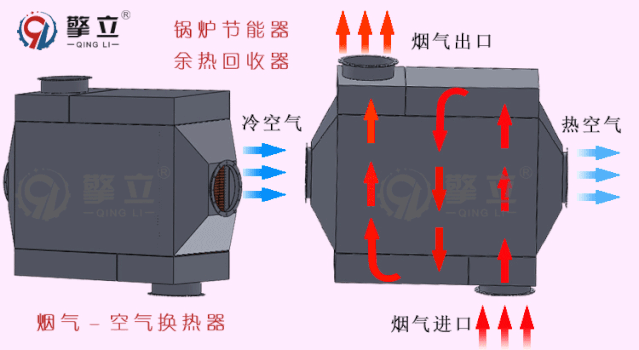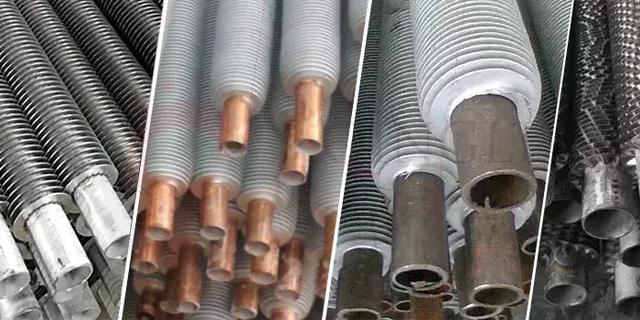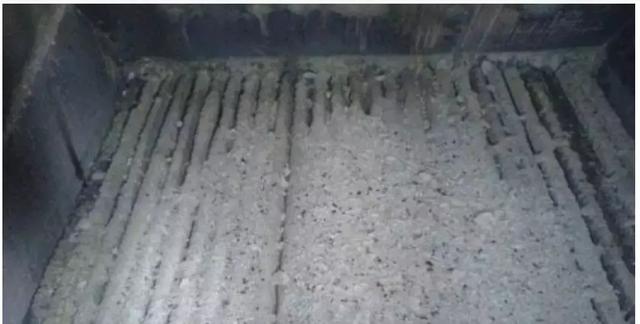 Home >
News Information >
Qingli News > Qingli Dry Goods | The principle of air preheater, the national leader in energy conservation and emission reduction
Home >
News Information >
Qingli News > Qingli Dry Goods | The principle of air preheater, the national leader in energy conservation and emission reductionFirst, the principle of air preheater
The above is the official explanation of Encyclopedia. In layman’s terms, the heat of the boiler exhaust gas is heated by the heat exchanger to the fresh air, and the hot air can be used as the boiler to support combustion or dry materials, etc.;
On the one hand, the temperature of the flue gas is reduced, which can meet the environmental emission standards;
On the other hand, the use of hot air can solve the energy consumption;
It is really a good thing that kills two birds with one stone, so we are the vanguard of national energy conservation and emission reduction. Let me explain the principle of the air preheater for you. First, look at the following animation to see the general idea:

We also call it a boiler economizer/air heat exchanger.
As can be seen from the above figure, the flue gas enters the equipment through the lower flue gas outlet, assuming a temperature of 280°C, and then is discharged from the upper flue gas outlet at a temperature of 130°C, which meets the emission requirements of the local environmental protection department, while the cold air on the left (assuming that the temperature is 130°C) 20 ℃) is also introduced into the equipment by the fan, after the heat exchange between the equipment and the flue gas, the hot air at 65 ℃ at the right outlet is not a very simple principle.
However, from the outside of the schematic diagram, you cannot see what the inside of the equipment is. You can also tell you that it is very simple. It is composed of heat exchange tubes. Like all heat exchangers, the high-temperature flue gas goes outside the tube, and the normal temperature air goes inside the tube. When the high temperature flue gas passes through the heat exchange tube, the heat is transferred to the normal temperature air in the tube, so as to achieve temperature rise and temperature drop.

Commonly used heat exchange tubes: wound sheet type, rolled tube type, high frequency welding type, when the flue gas temperature is relatively high, the tube will be used directly.
2. Calculation and selection of air preheater
The principle is very simple, but the calculation is difficult. For example, if you want to make an air preheater, you only know that it is a 4-ton gas boiler, and the exhaust temperature of the flue gas port is 280°C. Air to cool down, you can also know that the normal temperature air is about 20 ℃, so how much equipment is needed to meet this requirement? Do you know how much equipment has reached the cooling equipment and how much the room temperature air will heat up?
If you don’t know, this energy-saving plan cannot be implemented. What should you do? Ask Guangzhou Qingli to calculate and select the model. Now you can get the result in as little as 3 minutes.
Why so fast?
Because we have professional selection calculation software.

Click on the picture to view the detailed introduction of the selection software
The selection software independently developed by Qingli entrusts all the complex heat calculation to the software.
Just need to know the parameters that the user can know.
1. The exhaust temperature of the flue gas port, I don’t know if the nameplate parameters can be provided;
2. How much should the exhaust gas temperature drop?
3. Room temperature air temperature; (that is, the room temperature when in use)
4. How many degrees does the room temperature air need to rise to? This can also be omitted.
The software will automatically calculate how many air preheaters composed of heat exchange finned tubes are required to meet the user’s needs, and can also calculate the temperature rise and drop.
Knowing the principle of the air preheater, let’s take a look at the problems that the air preheater may encounter.
3. The air preheater burns and catches fire
A. Reason:
A large number of unburned combustibles deposited on the heat exchange tubes are the key reasons for the fire of the air preheater. In the initial commissioning stage of the boiler, in the case of ignition (oil ignition) and long-term low-load operation, due to incomplete combustion, The condensed oil mist (or biological particles) and unburned combustibles brought from the furnace are accumulated on the lower part of the middle layer of the air preheater and the heat transfer element at the cold end, which is the source of the fire.
B. Preventive measures:
Minimize the deposition of unburned combustibles on the air preheater
The key is to get the fuel to burn completely. When using oil for ignition and low-load oil injection, the oil temperature, oil pressure, and steam pressure should be appropriate, so that the oil atomization is good, and the air distribution is correct; the oil gun is not blocked, and there is no oil leakage; the combustion is stable and sufficient to minimize unburned exhausted combustibles.
Strengthen the monitoring of air preheaters
Before the unit is started, the air preheater should be fully inspected. If it is found or judged that there is a lot of unburned combustible accumulation in the air preheater, it must not be put into hot operation. It must be washed with water and then dried. It should be ensured that the soot blower can be put into normal operation and the parameters of the soot blowing medium are qualified.
During operation, especially after starting, restarting after hot standby, and after the air preheater suddenly stops and stops, the terminal temperature of the air preheater (air preheater flue gas inlet and outlet temperatures) should be closely monitored. If the temperature at one or more of these points rises abnormally, it should be analyzed and studied immediately so that a fire can be detected immediately. For example, if the exhaust gas temperature exceeds the normal value of about 30°C during operation, it indicates that it may catch fire. If it continues to rise, it is considered to be on fire. If the temperature continues to rise, it will definitely catch fire. When the furnace is stopped, the air preheater has stopped rotating, the inlet smoke temperature does not change or changes very little, and the outlet smoke temperature increases slowly at first, and then rises sharply, which also means that the air preheater is on fire. Operators should monitor the furnace flame and regularly observe the chimney. After the rotor of the air preheater stops, the current of the drive motor should be observed.
Experience shows that the fire is most likely to occur within a few hours after the furnace is shut down, and most of the operators have evacuated the site at this time, and the left-behind personnel often do not pay attention to the terminal temperature of the air preheater. For more than 1h, the loss increases. Therefore, familiarity with preheater performance and operating procedures is a prerequisite for monitoring air preheaters.
Install fire detection system
Infrared ignition detection system: Install several infrared probes at the air side inlet or outlet of the air preheater, and the probes move in a straight line. When the preheater rotates, it takes about 10 minutes to scan all the heat transfer elements once. If the air preheater catches fire locally and the infrared ray emitted exceeds the normal level, the system will issue an alarm signal. The advantage of this system is that it is highly sensitive and can detect fire conditions early. At this time, put a large amount of water to put out the fire immediately, and the fire will usually be put out quickly.
Effective soot blowing
A large amount of ash accumulation is not only easy to cause fire, but also reduces the heat transfer efficiency and increases the resistance of the air preheater. Because the cold end of the air preheater is most likely to accumulate dust, soot blowers are usually installed on the flue gas side of the air preheater outlet. In order to prevent fire, soot blowing must be effective. During normal operation, it is generally blown once every 8 hours; during start-up, it is blown once every 4 hours; .
In the initial stage of startup, if the parameters of the soot blowing steam cannot meet the requirements, it can be purged with compressed air.

air preheater dust
Proper water cleaning
The function of the air preheater soot blower is limited. For example, the heat transfer element in the lower part of the middle layer of the air preheater is easy to block soot, and the soot blower generally cannot be removed. It is therefore also important to perform proper water cleaning. In addition, some combustible scaling can only be removed by flushing with water. The general water cleaning cycle is 1~2 times/year. Be sure to dry the air preheater after cleaning with water, otherwise the air preheater will corrode and block dust quickly.
Add fire water system
Circular fire water pipes are installed on the flue gas side, primary air and secondary air sides of the air preheater, and dozens of nozzles are installed on the pipes.
Four, empty preheater fire treatment
The ignition of the air preheater often originates from the lower part of the intermediate layer and the cold end heat transfer element. It takes a long time to burn from a very small area to a large area, usually 1 to 2 hours, and sometimes longer. In order to reduce losses, determine whether there is a fire as soon as possible. Usually start from the temperature of the air preheater endpoint, and sometimes observe whether the fire is on through the observation hole of the air outlet of the air preheater. If a fire is found, the observation hole should be closed immediately. When the fire is serious, there will be smoke leakage or obvious radiation, and the chimney will emit black smoke.
When it is found that the air preheater has caught fire, the MFT should be manually operated immediately, the operation of the induced draft fan should be stopped, the air preheater should be isolated, and the inlet and outlet baffles of the air preheater should be closed. The air preheater keeps rotating, the fire water and multi-nozzle cleaning water pipelines are immediately put into extinguishing, and the drain on the flue gas duct is opened at the same time. Experience has shown that the use of foam, chemicals or steam to smother the flame is not effective, and it is critical to ensure the amount of fire fighting water at this time. After the air preheater is on fire, the inlet hole must not be opened to prevent air from entering the combustion support. As a last resort, such as the failure of the fire water and cleaning water pipes and no water input, the access hole can be opened and the fire extinguishing water from the power plant can be used. Note that the fire must be completely extinguished, and careful inspection will never leave troubles.
The above is all the content shared by Qingli this week, the principle of the air preheater, the calculation and selection of the air preheater, and the maintenance, prevention and treatment measures for the fire of the air preheater.